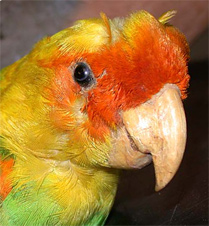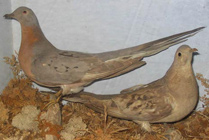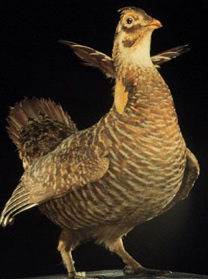
Non-Flying Birds | Birds of Prey | Extinct Birds | Waterfowl
The Carolina Parakeet
Scientific Name: Conuropsis Carolinensis

Characteristics
The Carolina Parakeet was small, about 30 cm. (12 inches) in length and weighed approximately 280 gram (10 ounces). The male and female were similar. Their forehead, lores, area around the eyes and the upper cheeks are orange, while the rest of the head and the upper part of the neck is yellow. The outer webs of primaries are marked with yellow towards their base. The bend of the wing, carpal edge and the thighs are yellow. The rest of their plumage is green, but paler on the under parts. This parakeet's bill is horn coloured. Their legs and feet are coloured pinkish brown. The juvenile Carolina parakeet's forehead, lores and the area around the eyes is brownish orange and the rest of the head and body is green. It has no yellow at the bend of the wing or on the thighs. Like other parakeets it has a pointed tail. The rest of the head and neck was yellow. The tail was pointed. Conuropsis carolinensis carolinensis had more yellow on the wings and a bluer tint of green.
Range & Habitat
The Carolina parakeet occurred in the U.S.A., in the states of Wisconsin, Indiana, Ohio, Nebraska, Colorado, Oklahoma, West Virginia, Kentucky and Tennessee to the Gulf of Mexico. Conuropsis carolinensis carolinensis occurred in southeastern USA ranged from central Texas to Colorado and southern Wisconsin across to the District of Columbia. Conuropsis carolinensis ludovicaina was found also in the United States on the western side of the Appalachian Mountain Ridge, through the Mississippi-Missouri drainage.
Habitat
Most often found in wetland forests of the southeastern United States. They would feed in a variety of places, however, including weedy fields, forests, orchards, and agricultural fields.The birds were wide-ranged but their typical habitat was cypress and sycamore trees along rivers and swamps
Food
The diet of the Carolina Parakeet was seeds of grasses, maple, elm, pine etc. and especially cocklebur The Carolina Parakeet switched to seeds of apple, peach, mulberry, pecan, grape, dogwood, and grains, after the forests were cleared for farms.
They regularly foraged in grain fields and orchards causing considerable damage. They were also feeding off mineral-rich soil. In captivity they were fed canary grass seed, hemp, maize, oats and breadcrumbs.
Extinction Causes
Its extinction was the result of the rapid cultivation of North America. This affected the parakeet in two ways. Its favourite habitat was destroyed and the birds were relentlessly persecuted, because their large flocks destroyed complete harvests of fruit farmers. They were considered a pest and large numbers were killed.
Common Name Passenger Pigeon
Scientific Name Ectopistes migratorius

Description
Male
Bill straight, of ordinary length, rather slender, broader than deep at the hase, with a tumid fleshy covering above, compressed towards the end, rather obtuse; upper mandible slightly declinate at the tip; edges inflected. Head small, neck slender, body rather full. Legs short and strong; tarsus rather rounded., anteriorly scutellate; toes slightly webbed at the base; claws short, depressed, obtuse. Plumage blended on the neck and under parts, compact on the back. Wings long, the second quill longest. Tail graduated, of twelve tapering feathers. Bill black. Iris bright red. Feet carmine purple, claws brackish. Head above and on the sides light blue. Throat, fore-neck, breast, and sides, light brownish-red, the rest of the under parts white. Lower part of the neck behind, and along the sides, changing to gold, emerald-green, and rich crimson. The general colour of the upper parts is greyish-blue, some of the wing-coverts marked with a black spot. Quills and larger wing-coverts blackish, the primary quills bluish on the outer web, the larger coverts whitish at the tip. The two middle feathers of the tail black, the rest pale blue at the base, becoming white towards the end.
Adult Female.
The colours of the female are much duller than those of the male, although their distribution is the same. The breast is light greyish-brown, the upper parts pale reddish-brown, tinged with blue. The changeable spot on the neck is of less extent, and the eye of a somewhat duller red, as are the feet.
Distrbution and Habitat
Made its home in the billion or so acres of primary forest that once covered North America east of the Rocky Mountains.
Diet
acorns, beechnuts, chestnuts, various fruits, grains and insects.
Extinction Causes
The Passenger Pigeon is now extinct. Over hunting, the clearing of forests to make way for agriculture, and perhaps other factors doomed the species.
The Health Hen
Scientific Name Tympanuchus cupido cupido

Physical Description:
These plump, 18.-in.-long game birds were light brown with black barring. They had a distinctive tuft of about 10 long pointed feathers on each side of their neck. The male had two orange air sacs on its throat, which it inflated with air during mating season and forcefully emptied to produce a booming call.
Where and How They Lived:
The heath hen's original range was the northeast coast of the U.S., from Maine to the Carolinas. It was generally found in the vicinity of oak trees. The hen's nest, an informal arrangement of leaves and grass placed over a hollow in the ground, was usually located at the base of a large stump in the woods. There the female would lay a dozen or more buff-colored eggs.
Diet
consisted of acorns and berries. An occasional foray might be made into an open field to search for tidbits of grain and clover
Extinction Causes
As the human population increased, the heath hen population decreased, largely due to hunting. By 1907 there were fewer than 100 heath hens left in the United States.
Efforts were made to save the remaining heath hens and a sanctuary was created for them on Martha's Vineyard, a small island off the coast of Massachusetts. By 1916 the population slowly increased to over 800 birds, but a large part of their breeding ground was destroyed by fire that year. This, along with an unusually harsh winter the following year and an increase in the goshawk population, reduced the heath hen population to 100 birds. By 1920 their numbers had doubled to 200 birds.
In 1921 a disease carried by domestic chickens spread to the heath hen population and their number dropped to 100 birds. By 1927 there were only 13 heath hens left. The last heath hen died in 1932.
Non-Flying Birds | Birds of Prey | Extinct Birds | Waterfowl
https://www.petermaas.nl/extinct/speciesinfo/carolinaparakeet.htm
https://www.ivorybill.com/g/carolinaparakeet.htm
https://sdakotabirds.com/species/carolina_parakeet_info.htm
https://www.ohiohistorycentral.org/entry.php?rec=1071
https://library.thinkquesthttps://www.audubon.org/bird/boa/F29_G3a.html
https://www.wbu.com/chipperwoods/photos/passpigeon.htm.org/TQ0312706/carolinaparakeets.htm